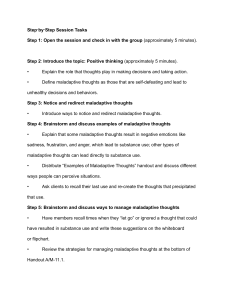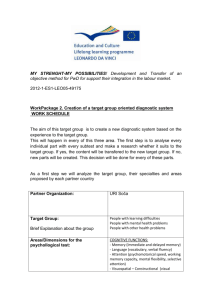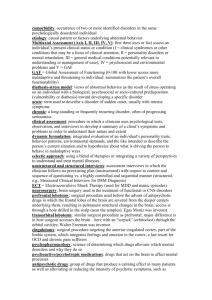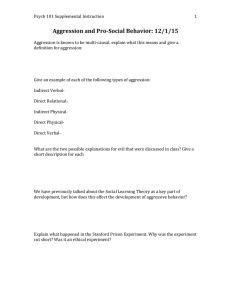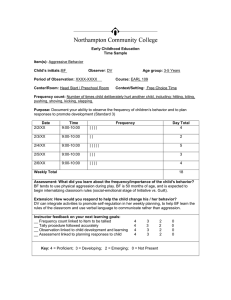2016 Gatlinburg Conference Poster PS-3
advertisement
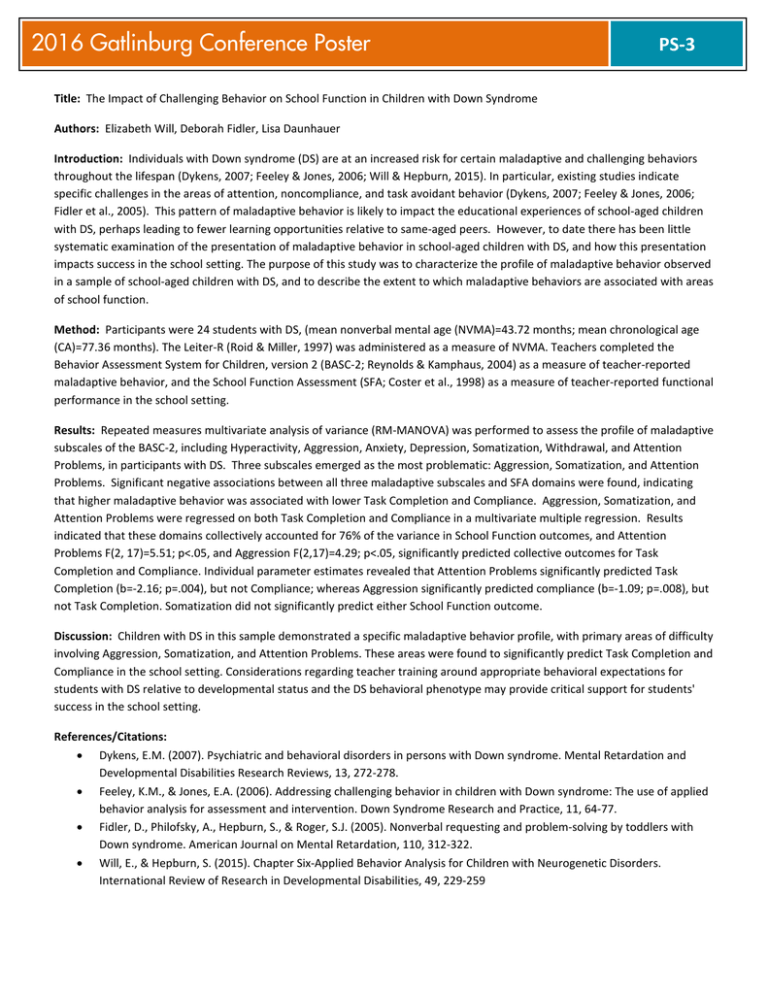
2016 Gatlinburg Conference Poster PS-3 Title: The Impact of Challenging Behavior on School Function in Children with Down Syndrome Authors: Elizabeth Will, Deborah Fidler, Lisa Daunhauer Introduction: Individuals with Down syndrome (DS) are at an increased risk for certain maladaptive and challenging behaviors throughout the lifespan (Dykens, 2007; Feeley & Jones, 2006; Will & Hepburn, 2015). In particular, existing studies indicate specific challenges in the areas of attention, noncompliance, and task avoidant behavior (Dykens, 2007; Feeley & Jones, 2006; Fidler et al., 2005). This pattern of maladaptive behavior is likely to impact the educational experiences of school-aged children with DS, perhaps leading to fewer learning opportunities relative to same-aged peers. However, to date there has been little systematic examination of the presentation of maladaptive behavior in school-aged children with DS, and how this presentation impacts success in the school setting. The purpose of this study was to characterize the profile of maladaptive behavior observed in a sample of school-aged children with DS, and to describe the extent to which maladaptive behaviors are associated with areas of school function. Method: Participants were 24 students with DS, (mean nonverbal mental age (NVMA)=43.72 months; mean chronological age (CA)=77.36 months). The Leiter-R (Roid & Miller, 1997) was administered as a measure of NVMA. Teachers completed the Behavior Assessment System for Children, version 2 (BASC-2; Reynolds & Kamphaus, 2004) as a measure of teacher-reported maladaptive behavior, and the School Function Assessment (SFA; Coster et al., 1998) as a measure of teacher-reported functional performance in the school setting. Results: Repeated measures multivariate analysis of variance (RM-MANOVA) was performed to assess the profile of maladaptive subscales of the BASC-2, including Hyperactivity, Aggression, Anxiety, Depression, Somatization, Withdrawal, and Attention Problems, in participants with DS. Three subscales emerged as the most problematic: Aggression, Somatization, and Attention Problems. Significant negative associations between all three maladaptive subscales and SFA domains were found, indicating that higher maladaptive behavior was associated with lower Task Completion and Compliance. Aggression, Somatization, and Attention Problems were regressed on both Task Completion and Compliance in a multivariate multiple regression. Results indicated that these domains collectively accounted for 76% of the variance in School Function outcomes, and Attention Problems F(2, 17)=5.51; p<.05, and Aggression F(2,17)=4.29; p<.05, significantly predicted collective outcomes for Task Completion and Compliance. Individual parameter estimates revealed that Attention Problems significantly predicted Task Completion (b=-2.16; p=.004), but not Compliance; whereas Aggression significantly predicted compliance (b=-1.09; p=.008), but not Task Completion. Somatization did not significantly predict either School Function outcome. Discussion: Children with DS in this sample demonstrated a specific maladaptive behavior profile, with primary areas of difficulty involving Aggression, Somatization, and Attention Problems. These areas were found to significantly predict Task Completion and Compliance in the school setting. Considerations regarding teacher training around appropriate behavioral expectations for students with DS relative to developmental status and the DS behavioral phenotype may provide critical support for students' success in the school setting. References/Citations: • Dykens, E.M. (2007). Psychiatric and behavioral disorders in persons with Down syndrome. Mental Retardation and Developmental Disabilities Research Reviews, 13, 272-278. • Feeley, K.M., & Jones, E.A. (2006). Addressing challenging behavior in children with Down syndrome: The use of applied behavior analysis for assessment and intervention. Down Syndrome Research and Practice, 11, 64-77. • Fidler, D., Philofsky, A., Hepburn, S., & Roger, S.J. (2005). Nonverbal requesting and problem-solving by toddlers with Down syndrome. American Journal on Mental Retardation, 110, 312-322. • Will, E., & Hepburn, S. (2015). Chapter Six-Applied Behavior Analysis for Children with Neurogenetic Disorders. International Review of Research in Developmental Disabilities, 49, 229-259
